|
|
|||||||
| Project Avalon General Discussion Finding safe places, information and resources for building communities, site suggestions. |
 |
|
|
Thread Tools | Display Modes |
|
|
|
|
#1 | |
|
Avalon Senior Member
Join Date: Sep 2008
Posts: 1,098
|
Hey all,
I find myself often wanting to post astronomy related things going on in the skies, and instead of making a new thread for every event, I figured it would be good to have one thread where anyone can post any upcoming events they come across. cool? or not cool?  To start it off, Tonight right after Sunset, about 9pm, http://www.astronomy.com/asy/default.aspx?c=a&id=8172 See Mercury, the Moon, and the Pleiades together in the night sky  Quote:
|
|
|
|

|
|
|
#2 |
|
Avalon Senior Member
Join Date: Oct 2008
Posts: 91
|
Orion..I think this is a great idea.
Cool 
|
|
|

|
|
|
#3 |
|
Avalon Senior Member
Join Date: Oct 2008
Location: Calgary, Canada
Posts: 711
|
Orion, what a fabulous idea!
  
|
|
|

|
|
|
#4 |
|
Avalon Senior Member
Join Date: Sep 2008
Location: Florida, USA
Posts: 301
|
*******
*** * Sgr A* - known by the Maya as "Hunab Ku" 'The Great Central Sun' of the Galaxy  This Chandra image of the supermassive black hole at our Galaxy's center, a.k.a. Sagittarius A* or Sgr A*, was made from the longest X-ray exposure of that region to date. In addition to Sgr A* more than two thousand other X-ray sources were detected in the region, making this one of the richest fields ever observed. During the two-week observation period, Sgr A* flared up in X-ray intensity half a dozen or more times. The cause of these outbursts is not understood, but the rapidity with which they rise and fall indicates that they are occurring near the event horizon, or point of no return, around the black hole. Absolutely, a good idea. It will be interesting to see other contributions * *** ******* Last edited by J_rod7; 04-27-2009 at 03:52 AM. |
|
|

|
|
|
#5 |
|
Avalon Senior Member
Join Date: Sep 2008
Posts: 1,098
|
thanks ladies, and bro.
  Jrod.. that is an amazing image!!!!!! not sure ive seen that one, i got another one that reminds of this one, from its description, Ill try to find it. that is beautiful man!!  thanks for sharing, i to look forward to what will be shared in this thread.  i love yas. <3 Ad Astra per Aspera!* p.s.. that image reminds me of being born for some reason. lol Last edited by Orion11; 04-27-2009 at 04:06 AM. |
|
|

|
|
|
#6 | |
|
Avalon Senior Member
Join Date: Sep 2008
Posts: 1,098
|
ahhh,
here it is , friends... 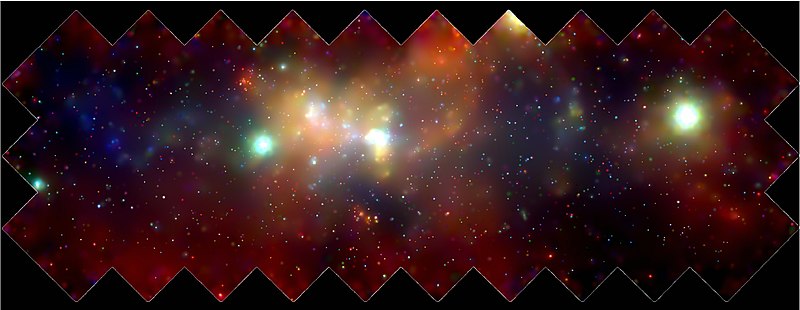 Quote:
|
|
|
|

|
|
|
#7 |
|
Avalon Senior Member
Join Date: Sep 2008
Location: Florida, USA
Posts: 301
|
*******
*** * LOVE the Mosaic, good find Orion11 Here are two nebula East and West of Sgr A* = This oval, shell-like feature is thought to be a supernova remnant, material from which may help fuel an accretion disk. (The red point in the image is the Sgr A* radio source.) Sgr A* East  Sgr A* West = Recent observations of atomic hydrogen gas suggest that some of these filamentary structures are part of massive cloud falling in toward the Galactic Center.  * *** ******* Last edited by J_rod7; 04-27-2009 at 04:15 AM. |
|
|

|
|
|
#8 |
|
Avalon Senior Member
Join Date: Sep 2008
Location: devon england
Posts: 1,905
|
O! rhythmm
absolutly lovin this one    keep it comin and thankyou   
|
|
|

|
|
|
#9 |
|
Avalon Senior Member
Join Date: Oct 2008
Location: Poland
Posts: 3,442
|
wonderful idea. I'll be checking the thread regularly.
|
|
|

|
|
|
#10 |
|
Avalon Senior Member
Join Date: Sep 2008
Posts: 1,098
|
 I was just out there a minute ago, and i got Jupiter and all its moons in the eyepiece!!! lol, first time ive gotten that!! woot!!   I could see the bands, the storm (red spot) and all its Moons... man.. soo very cool! . lol I watched it for over an hour, until it got to light out and it was drowned out. I got some pics to, they are on the cam, ill se ehow they came out before i go showin em. lol I just pulled this out of my stellarium... (the stars look extra big due to shining, in the program i guess, thr the scope they were alot finer and smaller than Jupiter. lol) and made it the same size as i saw it thru the scope, with the 9mm eyepiece.. just for kicks, really.  But this is what ive been staring at.. making contact, in a sense.. lol Edit: dang... does anyone else find it kind of annoying that we can only upload one pic per post? ive never personally seen that on any other forum.... its always at least 3.. and most of em like 10.. so we gotta make seperate posts in order for seperate pics... .. and they are also resized wicked small when uploaded thru the post. lol ok, sorry for that.. just had to get it out.   
Last edited by Orion11; 04-27-2009 at 10:14 AM. |
|
|

|
|
|
#11 |
|
Avalon Senior Member
Join Date: Sep 2008
Location: Florida, USA
Posts: 301
|
*******
*** * La présentation: The closest Star to Earth... This Star is best seen during daylight hours (LOL / ROFLOL) just after Sunrise, or before Sunset...::: Multiwavelength Sun coolcosmos.ipac.caltech.edu  Sun Pictures Gallery space.about.com  We should all keep an eye on this Beauty (DARK Sunglasses, fur shur) Yo, Orion, Great photo of Jupiter and 4-Moons. Will LOVE to see the shot through your 'Scope My 'Scope is an Orion modified Max-Cass with Equatorial mount, Orion Nebula looks good with it. Do we have some 'Synchronicity' at work here? * *** ******* Last edited by J_rod7; 04-29-2009 at 02:24 AM. Reason: add thought |
|
|

|
|
|
#12 | ||
|
Avalon Senior Member
Join Date: Sep 2008
Posts: 1,098
|
Quote:
 thats funny man....... just the other day... i said to a friend and his girlfriend... "hey... look at that star!!!!" (i even kinda pointed) LOL and they both looked all around for a bit.., and said.. "wheree??!??" lmaoo!! Quote:
what size scope? i wanna get a max-cass onea thse days.. when i fully learn the art of material manifestation. lol the synchronicity(s) are always at work ... everyday they show more n more. so.. fur shur!! haha.  thanks bro. 
|
||
|
|

|
|
|
#13 |
|
Avalon Senior Member
Join Date: Jan 2009
Location: Portugal
Posts: 303
|
Hi Orion,
Thank You for opening this thread. I love Astronomy! Every time I can, I go up to the country and do some night-sky observations with my 10x50 binoculars. It's great. This is a must-read thread!  Best Gemeos |
|
|

|
|
|
#14 |
|
Avalon Senior Member
Join Date: Sep 2008
Location: So. Cal. U.S.
Posts: 4,205
|
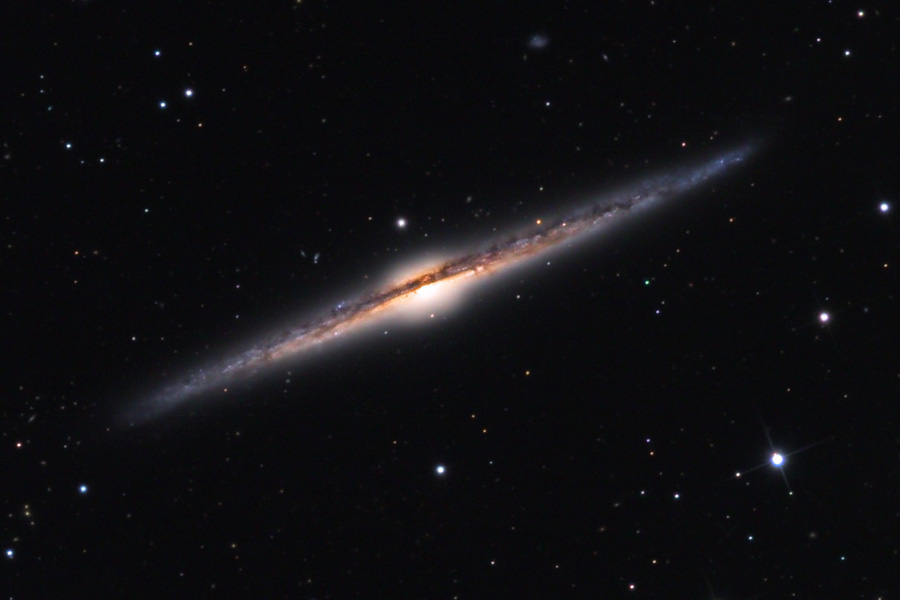 Explanation: Is our Galaxy this thin? We believe so. Magnificent spiral galaxy NGC 4565 is likely similar to our own spiral galaxy, but viewed edge-on from far away. Also known as the Needle Galaxy for its narrow profile, bright NGC 4565 is a stop on many telescopic tours of the northern sky as it lies in the faint but well-groomed constellation Coma Berenices. This sharp color image reveals the galaxy's bulging central core dominated by light from a population of older, yellowish stars. The core is dramatically cut by obscuring dust lanes which lace NGC 4565's thin galactic plane. NGC 4565 lies about 30 million light-years distant and spans over 100,000 light-years in diameter. Visible through a small telescope, some sky enthusiasts consider NGC 4565 to be a prominent celestial masterpiece Messier missed. |
|
|

|
|
|
#15 |
|
Avalon Senior Member
Join Date: Sep 2008
Location: So. Cal. U.S.
Posts: 4,205
|
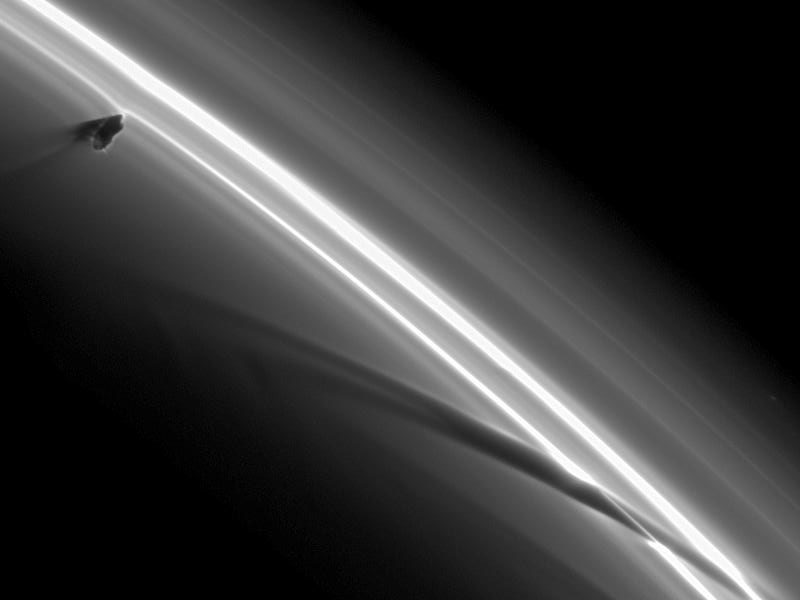 Explanation: What's causing those strange dark streaks in the rings of Saturn? Prometheus. Specifically, an orbital dance involving Saturn's moon Prometheus keeps creating unusual light and dark streamers in the F-Ring of Saturn. Now Prometheus orbits Saturn just inside the thin F-ring, but ventures into its inner edge about every 15 hours. Prometheus' gravity then pulls the closest ring particles toward the 100-km moon. The result is not only a stream of bright ring particles but also a dark ribbon where ring particles used to be. Since Prometheus orbits faster than the ring particles, the icy moon pulls out a new streamer every pass. Sometimes, several streamers or kinks are visible at once. The above photograph taken in mid-January by the robotic Cassini Spacecraft orbiting Saturn. The oblong moon Prometheus is visible on the far left of the image. |
|
|

|
|
|
#16 |
|
Avalon Senior Member
Join Date: Sep 2008
Posts: 1,098
|
damn thats sweet Dan!!
 the pic of Saturns rings.. to the top left.... almost looks like a 'worm hole' opening up... or closing. lol cuz you know.. ive seen soo many in my life! LOL thanks bro |
|
|

|
|
|
#17 |
|
Avalon Senior Member
Join Date: Sep 2008
Location: So. Cal. U.S.
Posts: 4,205
|
 Explanation: Last Sunday's fading evening twilight featured a young crescent Moon along the western horizon. The young Moon also shared the sky with the lovely Pleiades star cluster and wandering planet Mercury. Framed by clouds in this serene skyscape from Selsey, UK, a similar twilight scene was visible around the globe. Emerging from the cloud bank below the Pleiades, the narrow sunlit lunar crescent is overexposed. Still, the Moon's dim night side is impressively clear, illuminated by earthshine. Bright, innermost planet Mercury lies near the bottom of the field. Mercury will remain near the Pleiades, low in the west after sunset over the coming days, an ongoing conjunction of planet and star cluster that will offer skygazers some excellent binocular views. |
|
|

|
|
|
#18 | |
|
Avalon Senior Member
Join Date: Sep 2008
Location: Scotland
Posts: 974
|
Quote:
I can understand how we could see objects looking OUT from the galaxy but how have they managed to do the reverse? i.e. Looking at our galaxy from the outside... Thanks  Iain |
|
|
|

|
|
|
#19 |
|
Avalon Senior Member
Join Date: Sep 2008
Posts: 1,098
|
Hey Iain,
well, they really , truly do not know what our Mily Way galaxy looks like from the outside... I recently read something on a science site... that said many scientists now believe our Galaxy to actually have only 2 arms, rather than 4 as previously thought. interesting eh? |
|
|

|
|
|
#20 |
|
Avalon Senior Member
Join Date: Sep 2008
Posts: 1,098
|
Milky Way gets a makeover...
http://www.nasa.gov/mission_pages/sp...20080603a.html  http://www.viewzone.com/milkyway.html (good link, read this!)) http://www.wired.com/wiredscience/2009/01/milkyway/ http://www.manythings.org/voa/script...s_Thought.html http://news.cnet.com/8301-10784_3-9960025-7.html http://www.newscientist.com/article/dn14057 |
|
|

|
|
|
#21 |
|
Avalon Senior Member
Join Date: Sep 2008
Location: Florida, USA
Posts: 301
|
*******
*** * Iain, Quote under the photo: "Magnificent spiral galaxy NGC 4565 is likely similar to our own spiral galaxy,..." No, WE don't have any photos of our own Galaxy from anywhere but from here at Earth. If anyone "out-there" has any such photos, they haven't shared them with us. I wish they would share everything they have with us, but we shall just have to be patient. * *** ******* |
|
|

|
|
|
#22 |
|
Avalon Senior Member
Join Date: Nov 2008
Location: America
Posts: 171
|
Thanks to all those that posted these amazing pics!
|
|
|

|
|
|
#23 |
|
Avalon Senior Member
Join Date: Sep 2008
Location: Scotland
Posts: 974
|
Hey Orion - very cool pics

|
|
|

|
|
|
#24 | |
|
Avalon Senior Member
Join Date: Sep 2008
Location: Scotland
Posts: 974
|
Quote:
 That is interesting Orion yes. Are there any examples we know of out there of a galaxy only having 2 arms? 
|
|
|
|

|
|
|
#25 | |
|
Avalon Senior Member
Join Date: Sep 2008
Posts: 1,098
|
hey there bro.. you are welcome...
 and yep.. there are many actual pictures of real galaxies that have only 2 arms... Here is a couple.. M51  M81 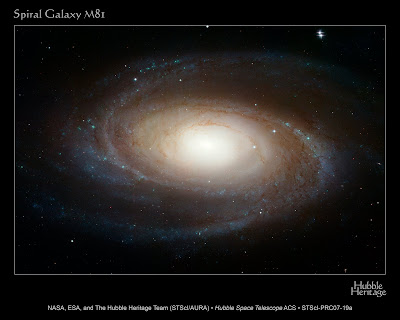 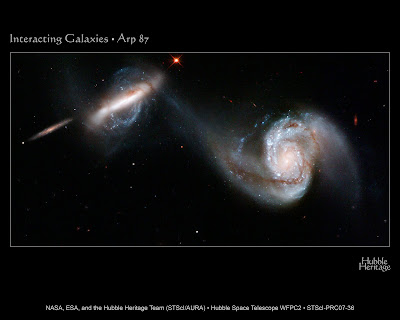 and this link.. i posted above.. http://www.viewzone.com/milkyway.html tells how we (our solar system) is really not from the milky way at all!! but from the Sagittarius dwarf galaxy.. its got some interesting stuff!!.. like... Quote:

Last edited by Orion11; 05-06-2009 at 11:11 PM. |
|
|
|

|
 |
| Tags |
| astronomy, celestial, events, moon, pleiades |
«
Previous Thread
|
Next Thread
»
|
|
All times are GMT. The time now is 04:59 AM.




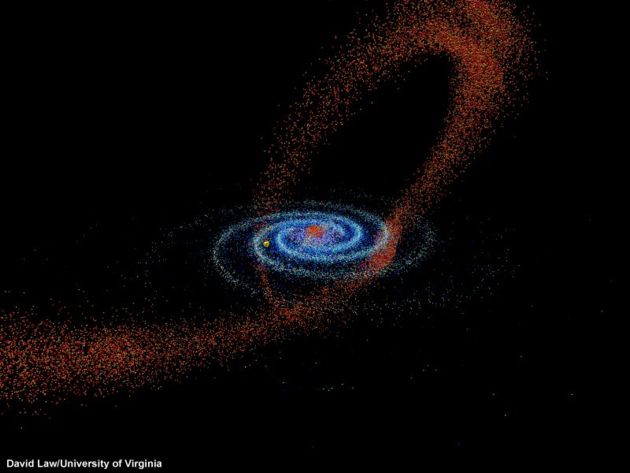


 Hybrid Mode
Hybrid Mode
